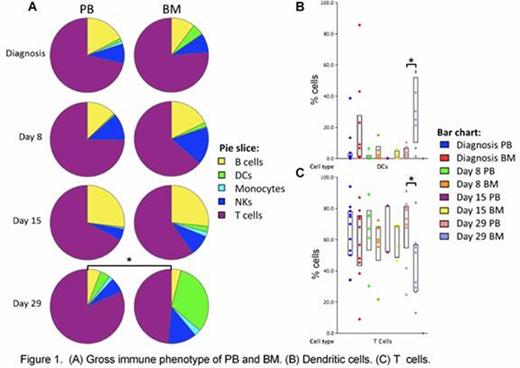Abstract
Perturbations in haematopoiesis are characteristic in acute leukaemia. The disturbed bone marrow (BM) microenvironment that results from high concentrations of tumour cells can cause reduced erythro-, leuko- and thrombo-poiesis. Lymphocyte recovery during remission induction chemotherapy has been linked with improved prognosis. However, correlations between recovery of other haematopoietic features (myelopoeisis and thrombopoiesis) and improved prognosis have been less frequently demonstrated, leading to postulation that selective lymphocyte expansion may occur as an immune response against tumour cells. In this study, we aimed to identify the immune phenotype of paediatric B cell acute lymphoblastic leukaemia (ALL) patients at diagnosis and throughout remission induction chemotherapy, including detailed characterisation of recovering lymphocyte subsets.
17 paediatric patients diagnosed with precursor B cell ALL at Alder Hey Children's Hospital between August 2014 and February 2015 were enrolled in this study. Diagnosis, risk group assignment and treatment were performed according to the UKALL2011 multicentre trials. Philadelphia chromosome positive B-ALL or ALL in patients with Down syndrome were excluded. This study was approved by Norfolk Research Ethics Committee (REC 14/EE/0211) and informed consent was obtained from patients and/or their legal guardians in accordance with the Declaration of Helsinki. 87 paediatric BM and peripheral blood (PB) tissue samples were collected from enrolled patients at time points co-ordinating with treatment protocol (diagnosis, and induction days 8 and/or 15 and 29).
Dendritic cells (DCs), monocytes, natural killer (NK) cells and T cells were stained with fluorochrome conjugated monoclonal antibody panels as proposed by the Human Immunophenotyping Consortium (Maecker et al., 2012 Nat. Rev. Immunol.) to allow comprehensive subset analysis and activation state determination, although panels used in this study were modified to allow data acquisition by six-colour flow cytometry. To include analysis of invariant natural killer T cells, cytokine induced killer cells, γd T Cells, B cells and characterisation of leukaemic blast phenotype a further 4 monoclonal antibody panels were used.
Precise definition of the normal lymphocyte subpopulations against the background of the malignant clone was possible by six-colour flow cytometry in all patients. Excluding tumour cells, the relative frequencies of all major cell populations; B cells, DCs, monocytes, NK cells and T cells, were similar in PB and BM aspirate at diagnosis (Figure 1A). T cells dominated the immune phenotype accounting for >60% of isolated mononuclear cells in PB and >70% in BM. B cells accounted for approximately 17% in PB and 9% in BM, DCs accounted for approximately 1.5% in PB and 4% in BM, monocytes accounted for approximately 1% in PB and 0.1% in BM and NK cells accounted for approximately 8% in PB and 7% in BM. No significant changes to this gross immune phenotype were observed through induction days 8 and 15. The immune phenotype of PB at day 29 was consistent with that recorded at diagnosis and earlier time points, but that of BM at day 29 was significantly altered compared to PB (p = 0.0087; Figure 1A). The relative frequency of DCs was significantly higher in BM compared to PB (p = 0.0007; Figure 1B), this was matched with a corresponding decrease in T cell frequency in BM compared to PB (p = 0.0020; Figure 1C).
The biological relevance of lymphocyte recovery following induction chemotherapy has yet to be elucidated with two broad theories emerging; (1) that lymphocytes constitute an important arm of cancer immune surveillance and function to promote the maintenance of remission once leukaemia burden has been reduced to minimal residual disease levels. And (2) that the rapid regeneration of normal haematopoiesis reflects a deeper leukaemia cytoreduction and consequently a better haematopoietic microenvironment facilitating recovery of blood counts. In this study, high numbers of T lymphocytes were recorded in the BM tumour microenvironment and their presence confirms the potential for generation of a tumour specific immune response. Further understanding of immune system reconstitution will provide insight into the immune response to childhood leukaemia and the potential of chemotherapy to favourably adjust immune-leukaemia equilibrium.
No relevant conflicts of interest to declare.
Author notes
Asterisk with author names denotes non-ASH members.


This feature is available to Subscribers Only
Sign In or Create an Account Close Modal